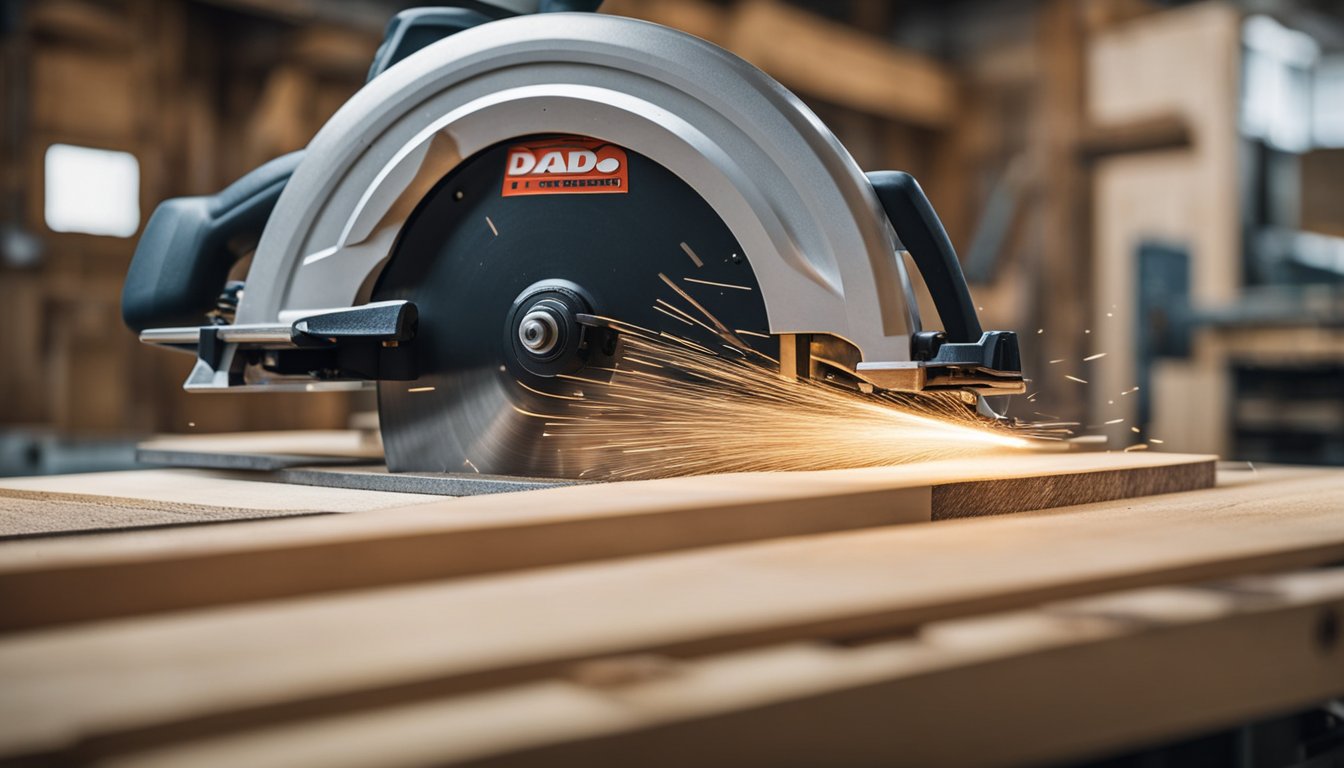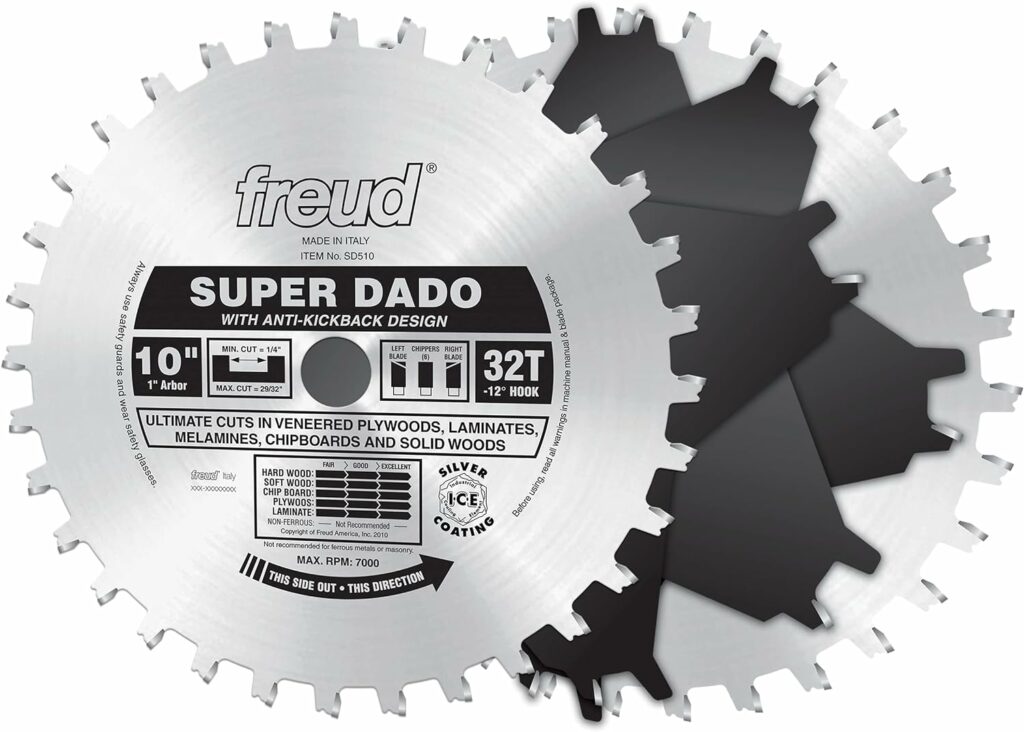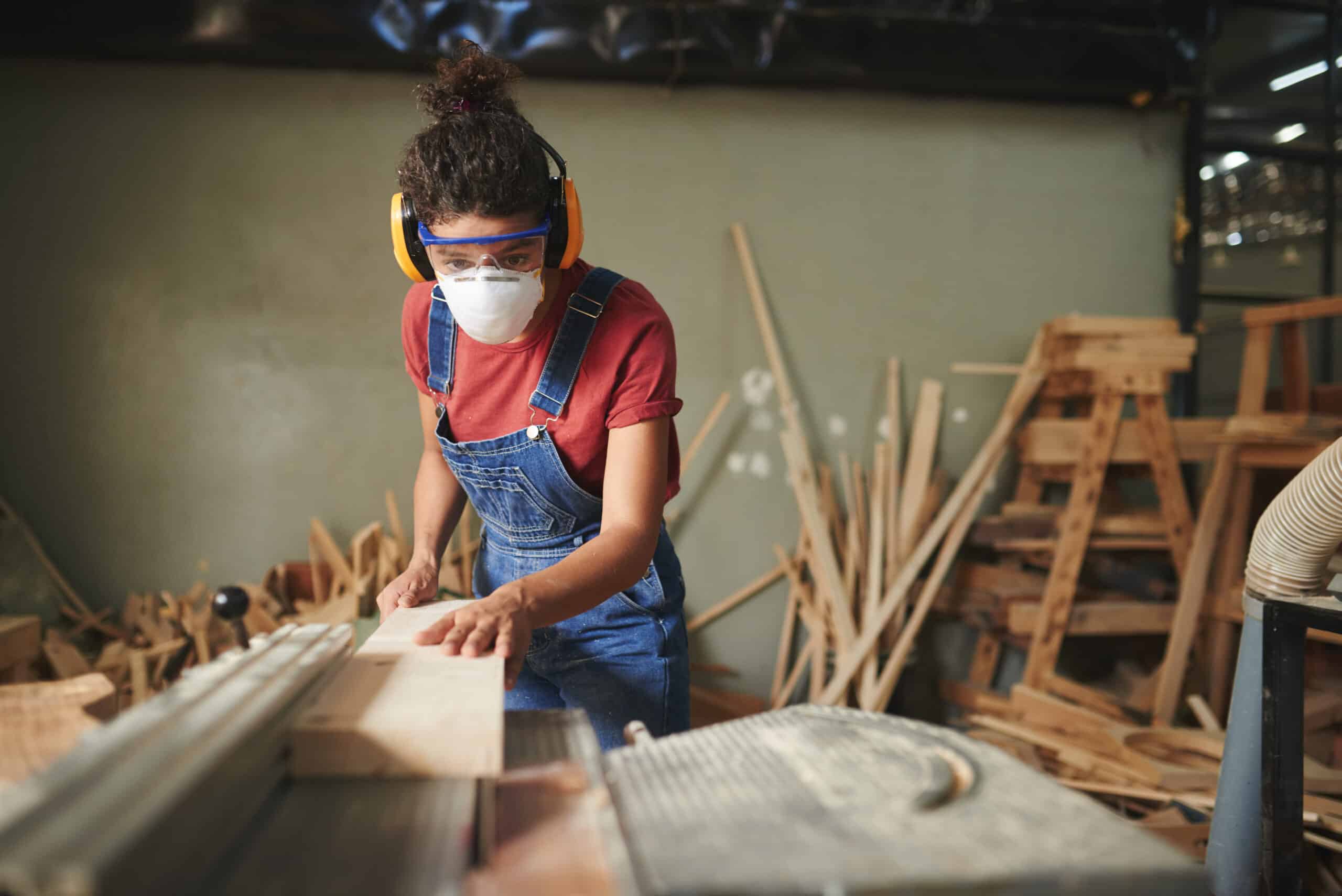A dado blade is a specialized circular saw blade used on table saws to cut wide, flat-bottomed grooves known as dadoes in wood. These grooves are essential in woodworking for creating joints such as those in bookshelves or cabinetry, where the stability of the structure relies on precise and strong connections. There are mainly two types of dado blades: stacked and wobble blades, with the stacked blade being the most popular due to its precision. The stacked dado set consists of two outer saw blades and a number of removable chippers and shims that can be inserted between them to achieve a variety of cutting widths.

Using a dado blade requires an understanding of how to safely install and operate it on your table saw. Proper set-up of the blade is crucial not only for achieving the precise width and depth of the cut but also to ensure safety during operation. You’ll need to select the appropriate type and size of the dado blade depending on the material and the kind of joint you intend to create. While using a dado blade, it is important to follow specific techniques, such as making test cuts and using feather boards for stability, to ensure accuracy and a clean cut.
Key Takeaways
- A dado blade is designed to create wide grooves for joinery in woodworking projects.
- Correct installation and usage of a dado blade are crucial for safety and precision.
- Selecting the right type of dado blade and employing proper techniques are essential for achieving the desired results.
Understanding Dado Blades
In the realm of woodworking, dado blades are specialized circular saw blades uniquely designed for cutting precise grooves in wood.
Types of Dado Blades
There are mainly two types of dado blades: the stacked dado blade and the wobble dado blade. A stacked dado set consists of two circular saw blades with a number of chipper blades and shims between them. This setup allows for adjustability in the width of the cut. On the other hand, a wobble blade pivots on its arbor, angling the cut to vary the width of the dado.
Components of a Dado Blade
Typically, a stacked dado blade includes two outer circular saw blades with a collection of chippers and sometimes chipper blades in between. These chippers cut out the middle portion of the dado, while spacers and shims can be used for micro adjustments in width. The entire assembly is held together on the arbor of a table saw by a nut.
Sizing and Compatibility
Sizing is crucial for dado blades. They must fit the arbor size of your table saw and be compatible with the throat plate. Common sizes include 6 to 8 inches in diameter with arbor sizes typically at 5/8 inches. When selecting a dado blade, check the maximum width it can cut, which usually ranges between 1/4 inch and 7/8 inch.
Dado Blade Materials and Quality
Dado blades are available in various quality levels and materials. Blades are usually made from steel or carbide, with carbide being the preferable material due to its longer-lasting sharpness. The number of teeth, their design, and the presence of a coating can influence the quality of cut. Higher-quality blades often have a higher number of teeth and may include a protective coating which contributes to both the quality of the cut and blade longevity.
Setting Up a Dado Blade

Setting up a dado blade on your table saw involves precise mounting, careful adjustments for accuracy, selecting the correct blade configuration, and adhering to important safety considerations.
Mounting the Dado Blade
To mount a dado blade, first ensure the table saw is unplugged. Remove the throat plate and blade guard, then loosen the arbor nut with a wrench. Place the dado blade over the arbor, making sure it’s flat against the washer.
Adjustments and Precision
After mounting, make micro-adjustments to align the blade with the miter slot for precision cutting. Use a combination square to measure from the miter slot to the blade. Add or remove shims or spacers to adjust the width of the cut to your project’s requirements.
Dado Blade Configuration and Installation
The configuration of your dado blade depends on the width of the cut needed. A stacked dado blade set includes two outer blades and a number of chipper blades. For wider grooves, add more chippers; use fewer for narrower cuts. Ensure the chippers are evenly distributed across the arbor for balance.
Safety Considerations
Prioritize safety by wearing safety equipment like goggles and hearing protection. Never start the saw until the dado blade has been properly installed and everything is securely tightened. Always use a push stick or push block to maintain a safe distance from the blade.
Dado Blade Applications in Woodworking
When tackling various woodworking projects, a dado blade becomes an indispensable tool in your arsenal, allowing you to execute a range of precise cuts for joints and grooves with confidence and efficiency.
Common Woodworking Joints
Dado blades enhance joinery in carpentry and woodworking by enabling you to make clean and precise cuts. Key joints include the rabbet and lap joints, which are foundational for frames and boxes. These joints provide the structural integrity needed in various constructions. The tongue-and-groove joints are perfected using a dado blade to ensure a snug and flush fit, which is essential for floor and wall paneling.
Creating Grooves and Dadoes
Your precision in woodworking can be showcased when creating grooves and dadoes—flat-bottomed grooves that receive another piece of wood. For instance, dado blades expertly fashion groove cuts in drawer sides to fit the drawer bottom. The use of a dado blade gives a flat-bottomed groove, which is a marker of quality in woodworking projects. In carpentry, it’s your go-to for creating precise grooves and dadoes that fit exactly as planned.
Crafting Shelves and Cabinets
Dado blades offer versatility in the construction of shelves, cabinets, and even complex bookshelves. The ability to adjust the width of the dado blade allows you to customize the grooves for various thicknesses, which is crucial for shelving and cabinet divisions. Whether you’re fitting door panels, creating dividers in cupboards, or assembling drawers, the dado blade empowers you to craft with unrivaled precision, making it a favored tool for woodworking projects.
Techniques and Tips
Mastering dado blades is essential for precise woodworking projects. By understanding the right techniques and using the appropriate tips, you can ensure clean cuts, reduce tear-out, and solve common problems efficiently.
Preventing Tear-Out and Ensuring Clean Cuts
To prevent tear-out and ensure clean cuts with your dado blade, a few strategies are key. First, consider using scoring blades whenever possible; they pre-score the material’s surface to minimize fraying and splintering. Always make sure your blades are sharp, and set the blade height just above the thickness of the material for optimal precision. A clamp guide or a well-aligned fence is crucial to maintaining the integrity of the cut line.
Jig and Fixture Use
Utilize jigs and fixtures to enhance the accuracy of your cuts. A straightforward jig can help with replicating cuts, providing stability, and supporting the workpiece during the cut. If you’re looking to create complex joinery or repeated cuts, proper fixture setup can guarantee consistency and precision. Remember to always secure fixtures firmly to prevent any movement that could affect cut precision.
Troubleshooting Common Problems
When you encounter common problems with dado cuts such as uneven bottoms or inaccurate widths, start by making sure your blade set is properly aligned. If the issue persists, small adjustments to the blade height or fence alignment may be necessary. Frequent cleanings and inspections of your blade for any signs of wear can pre-empt future issues. For solutions to specific problems, such as cuts that aren’t square, verify your miter gauge or sled, and make necessary corrections to your setup.
Advanced Dado Blade Topics
When upgrading your woodshop’s capabilities with a dado blade, selecting the right blade, understanding its influence on your work’s efficiency, and knowing how to maintain the blade are crucial elements to ensure top performance and longevity.
Selecting the Right Dado Blade

To select a suitable dado blade for your woodworking projects, consider the sizes and number of teeth. Typically, dado blades range from 6 to 8 inches; an 8-inch dado blade set is compatible with most 10-inch table saws. For quality and tooth geometry, there are flat-top grind (FTG) teeth for clean cuts and alternate top bevel (ATB) teeth that excel in minimizing tear-out. It’s also important to consider the hook angle; a lower angle often results in smoother cuts.
Influence of Dado Blade on Woodworking Efficiency
Dado blades significantly improve productivity and efficiency in woodworking. The ability to cut precise channels in a single pass transforms both the time-saving aspect and the accuracy of joinery work. Use a high-quality dado blade to optimize your workflow and enhance the efficiency of constructing joinery such as tenons, and rabbets, or for creating shelves.
Dado Blade Maintenance and Care
Consistent maintenance and care will keep your dado blade in optimal condition. Sharpening the teeth when they become dull is imperative; it’s recommended to seek professional services to maintain precision. Regular cleaning after use prevents pitch and resin build-up which can affect the blade’s performance. Store the dado blade set properly to avoid any damage to the teeth. A well-cared-for dado stack requires less frequent replacement, making it a wise investment for your workshop.
Supplementary Tools and Accessories
When using a dado blade, having the right supplementary tools and accessories ensures accuracy and efficiency in your woodworking projects. These additional items help you make precise cuts and adjustments with your saw blades and table saw, enhance your measuring capabilities, and guide your tools to perfection.
Saw Blades and Table Saws
Your dado blade setup should be complemented with high-quality saw blades. For example, when executing precise flat bottom dado cuts, consider blades with optimized tooth geometry. This can make a significant difference in the quality of the cut. Additionally, a sturdy table saw is indispensable. It’s the foundation of your workflow, so opt for a reliable one that’s compatible with your dado blade for smooth operations.
- Compatible Blades: Ensure your additional saw blades are compatible with your dado set for seamless workflow.
- Table Saw Stability: A stable table saw guarantees precision, reducing the risk of errors due to tool movement.
Measuring and Adjustment Accessories
Accurate measurements are crucial for woodworking success. Using precise measuring tools like calipers or dial indicators can help with micro-adjustments to guide your dado blade to the exact width required. Look for accessories that aid in measuring the insert cut depth or the width between blades.
- Calipers and Dial Indicators: For measurements down to the thousandth of an inch.
- Adjustment Tools: Select tools that allow fine adjustments without needing to remove your blade from the saw.
Guide Tools and Miter Saws
Guide tools such as clamp guides or jigs help ensure straight cuts with a miter saw or radial arm saw. A reliable miter saw equipped with a sharp blade can work alongside your dado set for angled cuts. Equally, if using a radial arm saw, ensure the guide tools are precise to maintain the accuracy of your cuts.
- Clamp Guides: Use clamp guides for straight and consistent cuts.
- Miter Saw Precision: A precise miter saw complements dado cuts, especially for joinery requiring angled cuts.
Making an Informed Purchase
When buying a dado blade set, your focus should not only be on the price but also on the features and suitability for your projects. It’s essential to conduct a thorough comparison, read expert opinions, and consider the blade’s versatility in relation to your specific needs.
Comparing Costs and Features
- Price range: Whether you are on a budget or willing to invest more, dado sets come in various price points. It’s crucial to compare the cost alongside the features offered.
- Features to consider: Look at the number of teeth, as this impacts the cut quality. The materials and configuration of the set affect durability and performance. For example, sets with carbide-tipped teeth may cost more but offer longer life expectancy and better results.
Reading Reviews and Seeking Recommendations
- Utilize credible sources: To ensure you are getting your money’s worth, check product reviews on websites like Amazon or woodworking forums. Buyers’ firsthand experiences can provide valuable insights.
- Expert advice: Seeking recommendations from woodworking professionals or trusted content channels adds another layer of confidence in your decision-making process. Buying guides or videos like “Best Dado Blade Sets Of 2022” offer expert perspectives on selecting the right set.
Considering Blade Versatility and Project Specs
- Evaluate versatility: A versatile dado blade set can handle different types of cuts and materials, which could be more cost-effective in the long run.
- Match to project specifications: Ensure that the blade set can accommodate the width and depth required by your project specifications. A set that includes shims, for instance, allows for fine adjustments, making it a versatile option for various applications.
By weighing the balance between cost, features, versatility, and expert recommendations, you can make an informed purchase that meets your woodworking needs.
Frequently Asked Questions
This section provides insights into some of the most common queries about dado blades, enhancing your understanding and helping you make informed decisions for your woodworking projects.
What are the various uses of a dado blade in woodworking?
A dado blade is primarily used for creating precise grooves, slots, and dadoes in wood, essential for joinery such as shelves or cabinet-making. These blades can cut a variety of widths in one pass, enabling efficient and versatile joinery work.
How do I choose the best dado blade for my projects?
When selecting a dado blade, consider the material you’ll be cutting, the type of woodwork you’re doing, and the compatibility with your table saw. Ensure the blade’s quality, tooth count, and material suit your project’s needs for clean and accurate cuts.
What should I look for in a dado blade set for a 10” table saw?
For a 10” table saw, you should look for a dado blade set that is compatible with the arbor size, provides a range of cutting widths, and includes high-quality carbide-tipped blades for durability and precision.
Can a dado blade be used on a circular saw, and if so, how?
While not typically recommended, a dado blade can be used on a circular saw by ensuring proper installation and support for the workpiece. However, for safety and precision, a table saw is the preferred tool for dado cuts.
What are the differences between a wobble dado blade and a stacked dado blade?
A wobble dado blade pivots to adjust the cut width but may result in less clean edges. A stacked dado blade consists of multiple blade shims and chippers, offering more precise and clean cuts with adjustable widths.
What are the legal restrictions on using dado blades in different countries?
Some countries, like the United Kingdom, have restrictions on the use of dado blades due to safety regulations. Familiarize yourself with your local laws before purchasing or using a dado blade.


